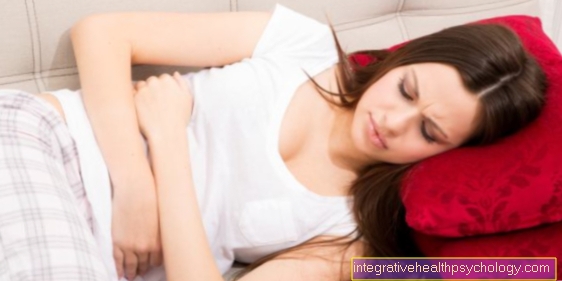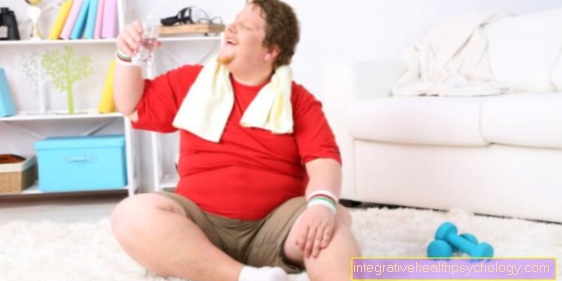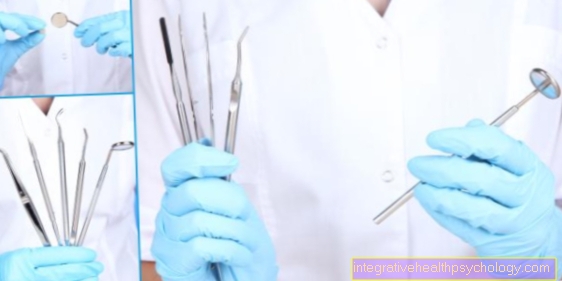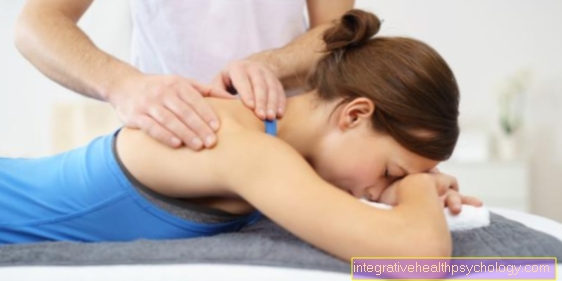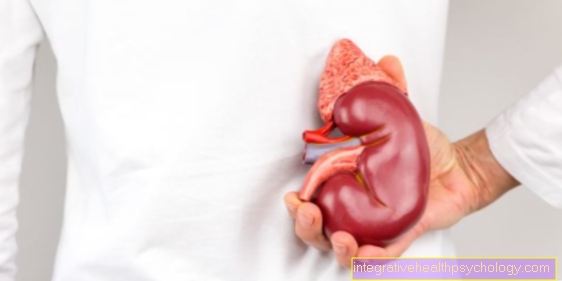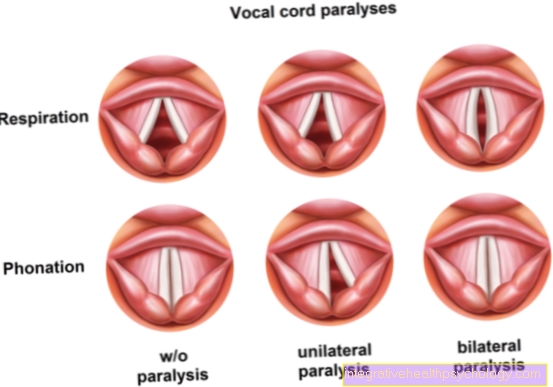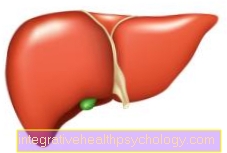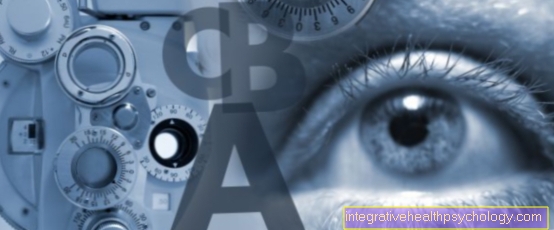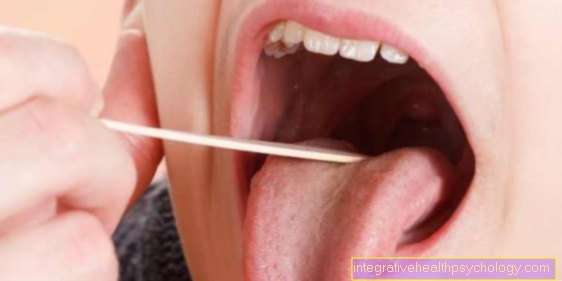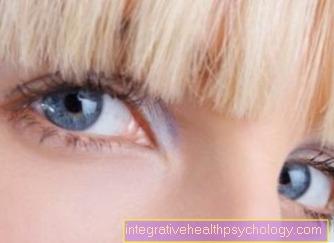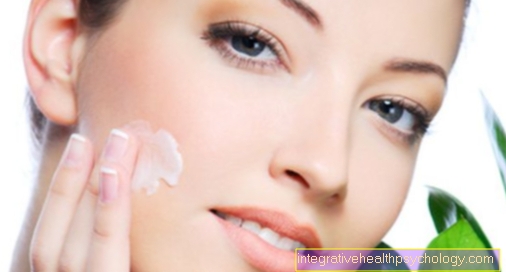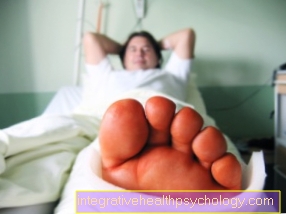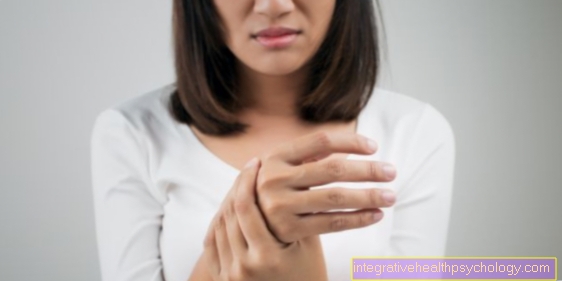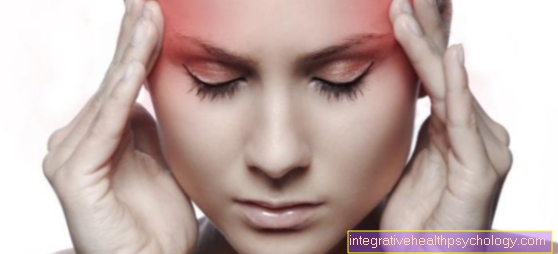Yeast fungus on the scalp
Definition - what is yeast on the skin?
Yeast fungi are part of the physiological flora of the skin and mucous membranes, so they also occur on the body under healthy conditions.
Here they feed on the secreted fat of the sebum glands.
The best known representative is the yeast Candida albicans. Normally, these yeasts do not trigger any symptoms.
In people with a weakened immune system or under warm and humid conditions, however, the fungi can multiply and thus lead to infections.
Yeasts are particularly common in skin folds, on the scalp, on the fingers and on the mucous membranes in the mouth and genital area.
Read more about the topic under: Yeast and yeast on the skin
causes
The trigger for a yeast infestation on the scalp is only in rare cases the yeast Candida albicans.
This is usually caused by another yeast, namely Malassezia furfur (also called Pityrosporum ovale).
This yeast is also part of the physiological skin flora, so it also occurs in small numbers in healthy people.
The scalp forms its reservoir of pathogen. Under special conditions, however, it can multiply here strongly and become symptomatic.
This appearance is then called bran fungus (Pityriasis versicolor).
Especially in the summer months, this is favored by the warmth and high humidity as well as increased sweating; the same applies to indoor pools and saunas.
Furthermore, some people also have a predisposition for a yeast infestation.
Patients with a weakened immune system or with certain diseases are particularly affected. A bad defense situation can e.g. if you have HIV infection (AIDS), cancer, cortisone therapy or prolonged use of antibiotics. Diabetics are also more often affected.
Other causes are overweight (obesity) and stress.
Read more on the subject under: Obesity
diagnosis
If a fungus attack on the scalp with flaking and other corresponding clinical symptoms is suspected to be bran fungus (pityriasis versicolor), the doctor can remove scalp flakes from the roughened skin by tearing off a piece of adhesive tape.
These are then examined microscopically. The fungus also shows a characteristic color when exposed to UV light.
If anything is unclear, a tissue removal (biopsy) can be carried out from deeper layers of the skin, which is performed under local anesthesia.
Read more about this under: Biopsy
Concomitant symptoms
Typical for a scalp attack with Malassezia furfur is the increased dandruff in combination with reddening and possibly itching.
The so-called "wood chip phenomenon" that can be observed is also characteristic:
- This describes how whitish scales can be removed when the affected areas are rubbed with a spatula, which resembles the appearance of planed chips.
If the infection is severe, other parts of the body such as the neck, chest or back can also be affected.
skin rash
The flaking of the scalp in the context of bran fungus is also accompanied by a rash, which is difficult to see on hairy skin if the scalp is isolated.
In people without scalp hair or if other parts of the body are infected, the affected skin areas can be recognized by sharply delimited, different-colored, small spots.
Their color varies from whitish to brown to reddish, which is why the addition "versicolor" in the medical name of the bran fungus Pityriasis versicolor comes about.
Hair loss
If the scalp is infected with yeast, increased hair loss can occur.
The cause of this is, on the one hand, the stressed, flaky scalp, which disrupts normal hair growth.
On the other hand, if there is also itching, hair can increasingly fall out due to excessive scratching on the affected areas. '
These changes generally regress completely after successful treatment of the yeast infestation
How are yeasts on the skin treated
The therapy of yeasts can be carried out both locally and systemically (affecting the whole organism).
Local therapy of the scalp is often carried out with pharmacy-only antifungal shampoos (effectiveness against fungi), which include contain the active ingredient ketoconazole.
This prevents yeasts like Malassezia furfur from multiplying.
Any other affected skin areas outside the scalp can be treated with creams containing ketoconazole. Other effective substances in creams or shampoos aim to reduce sebum production in order to remove the nutrient medium from the yeast.
These are, for example, zinc pyrithione or selenium disulfide. They are often combined with antifungal agents.
In addition, there is the option of systemic therapy with antifungal tablets containing substances such as fluconazole or itraconazole in the case of pronounced clinical pictures.
However, this form of therapy can also cause side effects more frequently.
Read more about this under: Medicines against fungal infections
Which shampoos can help?
Antifungal shampoos (effectiveness against fungi) are available in pharmacies.
In combination with ingredients that inhibit sebum production, it can effectively treat scalp yeast infestation.
Salicylic acid is also often added as it can mechanically dissolve the flakes.
The treatment takes place over several weeks.
It must take place daily and with an appropriate exposure time. Contact times between 10 and up to 30 minutes are recommended.
In some cases, however, the shampoo can cause contact allergies and skin irritation; then the attending physician should be consulted.
How contagious can yeasts be on the skin?
In contrast to other fungal skin diseases, bran fungus (pityriasis versicolor) of the scalp, which is caused by the yeast Malassezia furfur, is not contagious, not even in direct contact with the person concerned.
Other skin fungi, however, pose a risk of infection through direct contact. These skin fungi can also be transmitted via contaminated objects such as clothing etc.
Since mushrooms generally like it humid and warm, special care is required in public places such as swimming pools, saunas or toilets.
Read more about this under: How contagious are yeasts?
Which home remedies can help?
Various home remedies for skin fungi are known. In general, it is recommended to clean the affected areas with a mild soap before treatment and then carefully, e.g. with a towel to dry.
The fungus can then be treated by applying agents such as tea tree oil, whey, manuka honey, or diluted hydrogen peroxide solution.
Applying apple cider vinegar to the affected areas is also reported to be effective against skin fungus.
However, you have to be careful that the acid in the vinegar does not put additional strain on the stressed skin.
Another method is warm compresses soaked in chamomile. Here, however, there is a risk of the fungus growth being additionally favored by the warm, humid environment.
Duration
As soon as a yeast attack on the scalp has been diagnosed, appropriate treatment should be given for 4 weeks until the symptoms have subsided.
Previously affected areas of the skin can retain their blotchy, whitish to brownish appearance for some time after the end of therapy. However, this color change is completely reversed.
In the first two years after the fungal infestation, there is a high risk of recurrence (risk of renewed infestation) of up to 80%.
For prophylaxis, for example, an antifungal shampoo (effectiveness against fungi) can still be used once a week.
Systemic drug prophylaxis with tablets that are effective against fungal growth is also possible.




